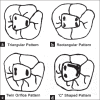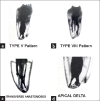Root Canal Configuration of Human Permanent Mandibular First Molars of an Indo-Dravidian Population Based in Southern India: An In vitro Study
- PMID: 29284938
- PMCID: PMC5731046
- DOI: 10.4103/jpbs.JPBS_163_17
Root Canal Configuration of Human Permanent Mandibular First Molars of an Indo-Dravidian Population Based in Southern India: An In vitro Study
Abstract
Aim: This study aims to analyze root canal configuration of human permanent mandibular first molars of an indo-Dravidian population based in southern India.
Materials and methods: A total of 1147 mandibular first permanent molars were collected, cleansed, and stored. The number of roots was recorded, access preparations made, pattern of orifices recorded after pulpal floor debridement, dye injected into the canals using apical negative pressure and subjected to a clearing technique. They were then analyzed using a stereo microscope and the canal configurations recorded (Vertucci). The number of roots, the pattern of orifices and canal configuration were recorded.
Results: The pattern of orifices was triangular (87.9%), rectangular (8.5%), C-shaped (3.0%), and two orifice pattern (0.6%). About 95.6% of teeth had two roots, and 4.4% had three roots. The most common canal system configuration in mesial root was Vertucci type IV (52.3%), followed by type II (35%). Root canal configuration of the distal root revealed type I configuration in 62.7%, followed by types II (14.5%) and IV (12.4%). The distolingual root had a type I configuration.
Conclusion: Awareness of canal configuration, adequate clinical skills, use of specialized techniques of diagnosis, debridement and obturation will pave the way for successful treatment outcomes.
Keywords: Distolingual root; indo-Dravidian population; pattern of orifices; root canal configuration.
Conflict of interest statement
There are no conflicts of interest.
Figures







References
-
- Cruse WP, Bellizzi R. A historic review of endodontics, 1689-1963, part 1. J Endod. 1980;6:495–9. - PubMed
-
- Cruse WP, Bellizzi R. A historic review of endodontics, 1689-1963, part 2. J Endod. 1980;6:532–5. - PubMed
-
- Fabra-Campos H. Three canals in the mesial root of mandibular first permanent molars: A clinical study. Int Endod J. 1989;22:39–43. - PubMed
-
- Ingle J. Endodontics. 2nd ed. Philadelphia: Lea and Febriger; 1976. p. 160.
-
- Walker RT. Root form and canal anatomy of mandibular first molars in a Southern Chinese population. Endod Dent Traumatol. 1988;4:19–22. - PubMed
LinkOut - more resources
Full Text Sources
Other Literature Sources
Research Materials

